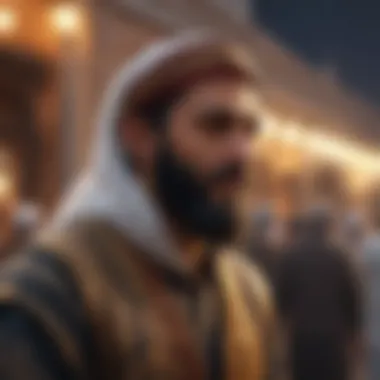The Islamic Holiday Calendar: A Comprehensive Overview


Intro
The Islamic holiday calendar is a significant aspect of Islamic culture and traditions. Unlike the Gregorian calendar widely used today, the Islamic calendar is lunar-based. This distinction affects not only the way holidays are scheduled but also influences how communities engage in various traditions throughout the year.
Understanding the Islamic holiday calendar involves examining its key holidays, cultural implications, and how these events reflect broader community practices. This article outlines the prominent Islamic holidays, their significance, and the connection between religious observances and social activities. It provides a detailed perspective for anyone interested in the complexities of Islamic timekeeping and the rituals associated with it.
The following sections will delve into important aspects of the Islamic calendar, offering a clear overview of its impact on the daily lives of Muslims worldwide. Through this exploration, we aim to illuminate the rich tapestry of beliefs and practices that constitute Islamic festivities and their broader implications in society.
Prolusion to the Islamic Holiday Calendar
The significance of the Islamic Holiday Calendar cannot be overstated. It serves as the framework for the timing of religious observances, traditions, and communal activities within the Islamic culture. Understanding the calendar is essential when exploring the various holidays that are integral to the faith and practice of Islam. These holidays not only reflect the religious beliefs but also the identity and values of Muslim communities around the world.
Overview of the Islamic Lunar Calendar
The Islamic calendar is lunar, consisting of 12 months and totaling 354 or 355 days each year. This deviation from the solar calendar creates an interesting essence in Islamic observances. Each month begins with the sighting of the new moon, which can vary based on geographical location. The lunar nature of the calendar means Islamic holidays shift approximately 10 days earlier each year, affecting not just the timing of observances but also the climate and social context in which these holidays occur.
This calendar comprises months like Muharram, Safar, and Ramadan, each holding its own significance and associated rituals. For example, Ramadan is crucial for fasting, while Muharram marks the beginning of the Islamic New Year. As such, the Islamic lunar calendar offers a unique perspective on the passage of time as perceived in the Islamic faith.
Importance of the Calendar in Islamic Culture
The Islamic calendar is more than just a timekeeping system; it is woven into the very fabric of Islamic life. It serves to regulate not only religious practices but also secular activities and cultural events. Key holidays like Eid al-Fitr and Eid al-Adha are pivotal moments in the Muslim calendar. They bring families and communities together, emphasizing unity and shared faith.
Moreover, the calendar reinforces the observation of important periods such as the Hajj pilgrimage, which has specific dates rooted in the lunar structure. The rhythm provided by the Islamic calendar underscores seasonal observances, including reflections on fasting and charity.
The Islamic calendar intertwines faith, culture, and community, serving as a timeless guide for Muslims worldwide.
Understanding this calendar also sheds light on various cultural expressions and local traditions that spring up around it, making the Islamic holiday calendar a rich and multifaceted aspect of Islamic life.
Key Components of the Islamic Calendar
Understanding the key components of the Islamic calendar is essential for grasping the significance of Islamic practices and observances. This calendar is fundamentally lunar, which means it is based on the phases of the moon. The Islamic calendar, also known as the Hijri calendar, consists of twelve months and is critical in determining religious holidays and days of observance. Knowing these periods gives insight into the practices that shape Islamic culture and community cohesion.
Months of the Islamic Calendar
The Islamic calendar comprises twelve months, each lasting either 29 or 30 days, depending on the sighting of the moon. The months are:
- Muharram: The first month, known for its solemn significance, especially for Shia Muslims.
- Safar: The second month, often associated with misfortune in some cultures.
- Rabi' al-Awwal: The third month, famous for the celebration of Mawlid al-Nabi, the birth of the Prophet Muhammad.
- Rabi' al-Thani: The fourth month, lesser-known but still recognized within Islamic communities.
- Jumada al-Awwal: The fifth month, marking the strife of early Muslims.
- Jumada al-Thani: The sixth month, with various cultural distinctions.
- Rajab: The seventh month, a sacred time for many Muslims, including the celebration of Isra and Mi'raj.
- Sha'ban: The eighth month, which precedes Ramadan and is a time of preparation.
- Ramadan: The ninth month, widely known for fasting and spiritual reflection.
- Shawwal: The tenth month, beginning with Eid al-Fitr, a celebration of breaking the fast.
- Dhu al-Qi'dah: The eleventh month, marking a time of peace and rest.
- Dhu al-Hijjah: The twelfth month, during which the Hajj pilgrimage takes place.
These months not only dictate religious observances but also influence daily life, from work schedules to social gatherings. The variations in month lengths, based on lunar sightings, create a calendar that shifts by approximately 10 to 12 days each year, affecting the timing of holidays and rituals.
Days of Celebration and Mourning
The Islamic calendar is punctuated by days of significant celebration and mourning, embodying various cultural and religious meanings. Major celebrations occur predominantly during the month's conclusive new moon phases.


Days of Celebration
- Eid al-Fitr: Celebrated on the first day of Shawwal, signaling the end of Ramadan with community prayers, feasting, and charity.
- Eid al-Adha: Observed on Dhu al-Hijjah, involving the ritual sacrifice of an animal, commemorating Ibrahim’s willingness to sacrifice his son.
- Mawlid al-Nabi: Commemorated on the 12th of Rabi' al-Awwal, celebrating the life of Prophet Muhammad.
Days of Mourning
- Ashura: The 10th day of Muharram, particularly significant for Shia Muslims, marking the martyrdom of Imam Hussein at Karbala.
- Tasu'a: Observed the day before Ashura, marking the events leading to the tragedy of Karbala.
The Islamic calendar serves not only as a chronicle of lunar months and significant days but also as a framework for community identity and shared faith.
Understanding the months and key days in the Islamic calendar enriches comprehension of Islamic life and worship. The interplay between the lunar months and these important days highlights the importance of timing in religious observance.
Major Islamic Holidays
The Islamic holidays hold great importance in the lives of Muslims around the world. These significant days are not only a time for celebration but also offer moments for reflection, community, and spirituality. Understanding these holidays is essential to grasp the essence of Islamic culture and religious practices. The key holidays, such as Eid al-Fitr, Eid al-Adha, Mawlid al-Nabi, and Muharram, each have unique characteristics that contribute to their importance.
Eid al-Fitr
Significance and Traditions
Eid al-Fitr marks the end of Ramadan, a month of fasting, prayer, and reflection. This holiday celebrates the completion of a spiritual journey, presenting an opportunity for Muslims to express gratitude and seek forgiveness. Traditions associated with Eid al-Fitr can vary widely but often include communal prayers, festive meals, and giving alms to the needy. One key characteristic is the communal nature of celebrations. People come together, strengthen bonds, and share joy, which is beneficial for community cohesion.
Eid al-Fitr’s unique feature lies in the practice of giving Zakat al-Fitr, a charity obligation that ensures everyone, especially those less fortunate, can partake in the festivities. However, this can sometimes create pressure on individuals to fulfill their charitable obligations, leading to stress during what is meant to be a joyous occasion.
Timing and Observance
Eid al-Fitr occurs on the first day of Shawwal, the month following Ramadan. The exact timing is determined by the lunar calendar and the sighting of the moon. This variability means the celebrations can differ from region to region. This aspect emphasizes the global diversity within Islamic practices, making this holiday a dynamic observance.
The timing of Eid al-Fitr promotes different local customs. Some communities may gather for prayers in large open spaces, while others may hold smaller, more intimate gatherings. This flexibility contributes positively to individual expressions of faith but may lead to confusion regarding the
Cultural Variations in Observance
The Islamic holiday calendar reflects a rich tapestry of cultural variations. This diversity is shaped by regional, historical, and social factors that influence how different communities observe Islamic holidays. Understanding these variations is essential, as they reveal insights into the unique identity and traditions of Muslim communities worldwide. Moreover, they highlight how cultural elements intermingle with religious practices.
Regional Practices
Regional practices surrounding Islamic holidays often showcase the local customs and traditions of different Muslim communities. For example, in Indonesia, the celebration of Eid al-Fitr is accompanied by a tradition known as "Salam Tempel." This involves visiting neighbors' homes to exchange greetings and gifts, enhancing a sense of community. Conversely, in the Middle East, it is customary for families to gather for large feasts, which reflects a different approach to communal celebration.
These distinctions can be attributed to local histories, resource availability, and social hierarchies. They enrich the observance of Islamic holidays, allowing them to be celebrated in varied and meaningful ways. Additionally, some regions may have specific rituals or songs that are integral to their observances, distinguishing them further.
Influence of Local Cultures
Local cultures deeply influence how Islamic holidays are celebrated. In many cases, traditional customs are intertwined with Islamic practices, resulting in unique celebrations. For instance, in West Africa, the celebration of Mawlid al-Nabi can incorporate traditional music and dance, which are not typically present in the celebrations in Arab countries.
Local cultural influences extend to food as well. The dishes served during Eid celebrations can differ vastly across regions. In South Asia, biryani might be a staple on the festive table, while in Turkey, kebabs and sweets hold prominence. Food reflects not just the resources of the area, but also familial and communal identities.


The blending of local customs with Islamic traditions can sometimes pose challenges. It can lead to tensions between maintaining religious purity and embracing cultural expressions. However, it also strengthens community bonds and fosters a sense of belonging that is vital in the global Islamic community.
Ultimately, understanding the cultural variations in the observance of Islamic holidays enhances appreciation for the diversity within the faith. It showcases how Islamic practice adapts to various cultural contexts, creating a dynamic and inclusive celebration of faith.
Cultural variations in observance of the Islamic holiday calendar demonstrate the multifaceted nature of Islamic traditions, emphasizing the importance of regional identity while embracing universal beliefs.
Impact of the Islamic Holiday Calendar on Daily Life
The Islamic holiday calendar deeply influences daily life for many communities around the world. Understanding these impacts helps in recognizing how traditions shape social interactions, community cohesion, and personal behaviors. Throughout the year, the observance of various holidays creates a rhythm that informs cultural practices and social engagements.
Social and Family Gatherings
One of the most noticeable impacts of the Islamic holiday calendar is seen in social and family gatherings during key holidays. Events such as Eid al-Fitr and Eid al-Adha serve as significant occasions for families to come together. During these times, relatives gather, meals are shared, and bonds are strengthened.
- Eid al-Fitr marks the end of Ramadan, and families celebrate with feasts, exchanging gifts and enjoying each other's company. This holiday fosters a sense of belonging, as families reflect on their spiritual journeys and accomplishments throughout Ramadan.
- Eid al-Adha is similarly important, as it celebrates sacrifice and charity. Families gather not only for meals but also to participate in ritualistic practices, such as Qurbani, the sacrifice of an animal. Sharing the meat with those in need enhances community bonds and emphasizes the values of generosity and caring for others.
These social gatherings often extend beyond immediate family, inviting neighbors and friends into the celebrations. Such inclusivity underscores the communal aspect of Islamic holidays, reinforcing connections within larger community contexts.
Community Engagement and Volunteerism
The impact of the Islamic holiday calendar is also evident in community engagement and volunteerism. Many Islamic holidays motivate acts of charity and service. For instance:
- During Ramadan, it is a common practice to prepare food and provide assistance to those less fortunate. This spirit of giving fosters a communal approach to welfare and support.
- Eid al-Fitr includes the giving of Zakat al-Fitr, a charitable donation intended to ensure that every individual can partake in the feast regardless of their circumstances.
- The practice of gathering for communal prayers during holidays encourages individuals to engage collectively, reinforcing community ties and collaboration.
These acts of volunteerism during notable holidays can lead to more sustained community projects throughout the year, illustrating the calendar's role beyond just religious observance. Engaging in charity emerges from the core teachings of Islam, which emphasize social responsibility and helping those in need.
The observance of Islamic holidays serves more than a spiritual purpose; it creates a framework for social cohesion and active participation in community life.
In summary, the impact of the Islamic holiday calendar on daily life is profound. It shapes not only how individuals connect with their families but also how they engage with their communities. Recognizing these elements enriches the understanding of Islamic culture and its rituals, revealing a framework built on togetherness, generosity, and shared values.
Challenges in Observing the Islamic Calendar
The Islamic calendar presents distinct challenges for individuals and communities observing its unique timing and traditions. Understanding these challenges is essential for appreciating the complexities of Islam's lunar-based system, and how these factors can affect daily life and religious practices. Such challenges include global synchronization issues and cultural assimilation, both of which significantly impact how Islamic holidays are celebrated around the world.
Global Synchronization Issues
One of the primary difficulties faced in observing the Islamic calendar is the lack of synchronization between lunar and solar calendars. The Islamic calendar consists of twelve months that rotate through the seasons over a 33-year cycle, making it about ten to eleven days shorter than the Gregorian calendar. This variability causes significant discrepancies in holiday observance across different regions.
- Regional Difference: The start of each month depends on the sighting of the moon. As a result, communities may celebrate holidays on different days, leading to confusion and disunity among Muslims globally.
- Variation in Practices: For example, Eid al-Fitr might be observed one day in one country, while neighboring nations celebrate it the next day. Such differences can affect families and communities separated by national borders.
This inconsistency in the timing of Islamic holidays can create challenges for community cohesion. In areas with a significant Muslim population, diverse observance dates may lead to fragmented celebrations, impacting social and familial bonds greatly.
Cultural Assimilation and Identity
Cultural assimilation presents another challenge for the observance of the Islamic calendar. As Muslim populations integrate into diverse societies, the pressures to conform to local customs can sometimes dilute traditional practices and the overall significance of Islamic holidays.


- Adaptation of Practices: In non-Muslim majority regions, members of the Islamic community may feel compelled to modify their observance of holidays to blend into local cultures. This adaptation can lead to a loss of authenticity and historical significance, making traditional practices less recognizable.
- Identity Crisis: Young Muslims in pluralistic societies might struggle to maintain their cultural identity amidst societal pressures. They navigate between their rich heritage and the demands of surrounding environments that may not recognize the Islamic calendar day's importance. This friction can foster a sense of disconnection from cultural roots.
Cultural identity is a nuanced territory, particularly when individuals find themselves balancing their traditions and the expectations of a diverse society.
Overall, these challenges underline the need for Muslims worldwide to emphasize the significance of the Islamic holiday calendar. While the Islamic calendar creates unique obstacles for observance, it also fosters a resilient sense of identity rooted in rich traditions and communal values that can thrive even in changing cultural landscapes.
Future Considerations for the Islamic Calendar
The Islamic holiday calendar represents a dynamic and integral aspect of Islamic culture and identity. As society changes, the practices surrounding this calendar also undergo evolution. It is crucial to examine future considerations related to the Islamic calendar to understand how modernity and tradition can coalesce. This analysis includes significant elements such as cultural adaptation and the impact of technology.
Evolution of Practices
As generations change, so do traditions. The evolution of practices related to the Islamic holiday calendar illustrates how cultural shifts influence religious observance. Many Muslims are adapting their practices to fit contemporary lifestyles. For instance, the traditional forms of celebration can combine with modern interpretations.
- Increased Mobility: Many people travel for holidays, which may require adjustments in tradition. Families may not always gather on the specific day of a holiday. They might celebrate on the nearest weekend.
- Globalization: Exposure to diverse cultures brings new ideas into Islamic celebrations. Some practices may blend with local customs, making celebrations unique to different regions.
- Social Media Influence: The rise of social media platforms helps in sharing and promoting Islamic traditions. It allows younger generations to connect with their roots while innovating new practices that align with their lifestyle.
Adaptations may help maintain relevance, but they also raise questions about the preservation of core values. The challenge lies in ensuring that modernization does not erode the significance of the holidays themselves.
Role of Technology and Digital Calendars
The digital age introduces numerous possibilities regarding how the Islamic holiday calendar is utilized. Technology can enhance the observance and understanding of these significant events. Digital calendars, often accessible through mobile apps, help followers stay up-to-date with holiday timings and events. This role of technology can greatly impact how the Islamic calendar is viewed and used.
- Accessibility: Digital platforms make the Islamic calendar accessible globally. This accessibility is crucial for Muslims living in non-Islamic countries, helping them stay connected to their religious observances.
- Synchronization: Many apps now automatically calculate Islamic dates based on lunar cycles. This synchronization helps to avoid confusion regarding the timing of holidays, especially when observing them across different time zones.
- Community Engagement: Online platforms offer spaces for community discussions around celebrations, traditions, and the significance of holidays. People can share experiences and learn from each other.
As the Islamic holiday calendar continues to evolve, recognizing the balance between tradition and technology becomes essential. This balance can enable community growth while still respecting the historical and cultural significance of these observances.
In summary, the future of the Islamic holiday calendar involves a delicate fusion of tradition and innovation. Embracing change while holding onto core values will shape the observance of these important dates moving forward.
End: The Significance of the Islamic Holiday Calendar
The Islamic holiday calendar holds significant importance for the Muslim community around the world. It serves as more than just a timeline for events; it shapes spiritual lives, informs social gatherings, and influences cultural practices. The significance of this calendar emerges from its deep-rooted connection to Islamic beliefs and traditions.
Understanding this calendar is essential to grasp the essence of Islamic celebrations and their meaning. Each holiday reflects fundamental aspects of Islamic faith. Eid al-Fitr and Eid al-Adha, for example, emphasize charity, gratitude, and community unity. Such holidays foster a sense of belonging among Muslims, bridging gaps between families, friends, and communities.
The calendar also plays a crucial role in the rhythm of everyday life for Muslims. Importantly, it affects everything from work schedules to school calendars, impacting how communities organize themselves.
"The Islamic calendar is a reflection of identity, connecting believers to their faith, heritage, and community."
Reflecting on Cultural Heritage
Cultural heritage is closely tied to the Islamic holiday calendar. Each holiday brings treasured traditions, practices, and ways of expressions passed down generations. For instance, Eid al-Fitr often includes specific food preparations unique to particular cultures. Whether it's sweet dates in the Middle East or baklava in Turkey, food traditions play a vital element of celebration.
Furthermore, communities celebrate in ways that reflect their local customs, transforming global observances into localized expressions. This fusion strengthens cultural identity while maintaining connections to Islamic teachings. Additionally, storytelling is a prevalent tradition during these holidays. Narratives about historical events associated with the holidays resonate with people, imparting moral lessons and fostering a sense of community.
The Calendar's Role in Modern Society
In today's rapid-paced world, the Islamic holiday calendar retains its significance. It adapts to contemporary life while fostering traditions. The role of technology in managing and observing this calendar cannot be overstated. Digital calendars and apps allow individuals to track Islamic dates effectively, bridging traditional practices with modern convenience.
Moreover, the calendar enriches the societal fabric by promoting inclusivity. Interfaith dialogues often emerge during holidays, enhancing understanding among diverse communities. It creates room for respect and empathy for cultural practices, encouraging broader social interactions.
The Islamic calendar thus serves as a reminder of shared values and beliefs amidst a global landscape marked by diversity. As society evolves, it will transition alongside, ensuring that core principles remain intact while embracing change.



